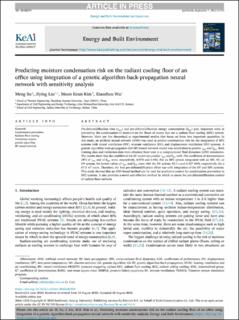| dc.contributor.author | Su, Meng | |
| dc.contributor.author | Liu, Jiying | |
| dc.contributor.author | Kim, Moon Keun | |
| dc.contributor.author | Wu, Xiaozhou | |
| dc.date.accessioned | 2023-07-31T11:14:46Z | |
| dc.date.available | 2023-07-31T11:14:46Z | |
| dc.date.created | 2022-09-26T16:51:30Z | |
| dc.date.issued | 2022 | |
| dc.identifier.citation | Energy and Built Environment (EBE). 2022, . | en_US |
| dc.identifier.issn | 2666-1233 | |
| dc.identifier.uri | https://hdl.handle.net/11250/3081941 | |
| dc.description.abstract | Pre-dehumidification time (𝜏�pre ) and pre-dehumidification energy consumption (Epre ) play important roles in preventing the condensation of moisture on the floors of rooms that use a radiant floor cooling (RFC) system.
However, there are few theoretical or experimental studies that focus on these two important quantities. In
this study, an artificial neural network (ANN) was used to predict condensation risk for the integration of RFC systems with mixed ventilation (MV), stratum ventilation (SV), and displacement ventilation (DV) systems. A genetic algorithm-back-propagation (GA-BP) neural network model was established to predict 𝜏�pre and Epre . Both training data and validation data were obtained from tests in a computational fluid dynamics (CFD) simulation.
The results show that the established GA-BP model can predict 𝜏�pre and Epre well. The coefficient of determination (R2) of 𝜏�pre and of Epre were, respectively, 0.973 and 0.956. For an RFC system integrated with an MV, SV, or DV system, the lowest values of 𝜏�pre and Epre were with the DV system, 23.1 s and 0.237 kWh, respectively, for a 67.5 m3 room. Therefore, the best pre-dehumidification effect was with integration of the DV and RFC systems.
This study showed that an ANN-based method can be used for predictive control for condensation prevention in RFC systems. It also provides a novel and effective method by which to assess the pre-dehumidification control of radiant floor surfaces. | en_US |
| dc.language.iso | eng | en_US |
| dc.rights | Attribution-NonCommercial-NoDerivatives 4.0 Internasjonal | * |
| dc.rights.uri | http://creativecommons.org/licenses/by-nc-nd/4.0/deed.no | * |
| dc.title | Predicting moisture condensation risk on the radiant cooling floor of an office using integration of a genetic algorithm-back-propagation neural network with sensitivity analysis | en_US |
| dc.type | Journal article | en_US |
| dc.type | Peer reviewed | en_US |
| dc.description.version | publishedVersion | en_US |
| cristin.ispublished | true | |
| cristin.fulltext | original | |
| cristin.qualitycode | 1 | |
| dc.identifier.doi | 10.1016/j.enbenv.2022.08.004 | |
| dc.identifier.cristin | 2055635 | |
| dc.source.journal | Energy and Built Environment (EBE) | en_US |
| dc.source.pagenumber | 0 | en_US |

